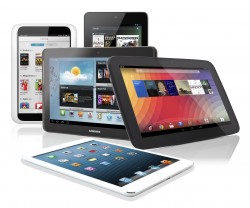New Windows 8 Hardware Specs Hint at Cheap 8″ Tablets And Not 7″
 News is breaking this week that Microsoft has lowered the bar for future Windows 8 devices. ZDNet picked up the story yesterday:
News is breaking this week that Microsoft has lowered the bar for future Windows 8 devices. ZDNet picked up the story yesterday:
The new guidelines relax the minimum resolution for Windows 8 devices to 1024 x 768 at a depth of 32 bits. That’s a significant change from the current guidelines, which require a minimum resolution of 1366 x 768 for a device to be certified with the Windows 8 logo. (Windows 8 currently supports the lower resolution for DIY installations by hobbyists, but OEMs have been prohibited from selling new devices with native resolutions lower than 1366 x 768.)
…
The idea of an inexpensive 7-inch Surface-branded Reader, running at a resolution of 1024 x 768 with full access to Barnes & Noble’s extensive library, is indeed intriguing. And of course it wouldn’t be just for e-books. With the ability to run the Amazon Kindle app and access the massive Xbox music, video, and games platform it would be instantly useful as an entertainment device.
The reason that the screen resolution is important is that you generally cannot find a tablet smaller than 10″ that has a resolution of 1366×768. I double-checked on Amazon, and I could find a few dozen 10.1″ (and larger) tablets with that screen resolution but not any 8″ or 7″ tablets. There is a single 7″ tablet (the Nook HD) which has a screen resolution greater than 1366×768, but that’s the only one so far.
Clearly Microsoft is planning to encourage Windows 8 on smaller tablets, but I’m not so sure their main interest is with 7″ tablets. I think MS is also keeping their options open for the super cheap 8″ tablets as well.
The thing that ZDNet (and Mike Cane) missed about the 1024×768 is that hardly any 7″ tablets are using a screen with that resolution. Sure, there are quite a few with a higher resolution screen, including the Kindle Fire HD, nexus 7, but not many.
There are a few 7″ tablets on Amazon that have a 1024×768 resolution screen, but that screen resolution is much more likely to be found on cheap 8″ tablets.
That is why I think the price point for the 8″ tablets is what Microsoft is really going after, not the 7″ tablets. The 8″ screen panel is cheap, and that means it will go in cheap tablets.
On a related note, if Microsoft was focused on 7″ tablets then why did they exclude tablets with a screen resolution of 1024×600? That screen size is fairly common on 7″ tablets.
IMO price is the key point here more so than screen size.
P.S. If I am correct then much of the Nook Media speculation that ZDNet and Mike Cane are spinning turns out to be a misinterpretation of the evidence. What do you think?
Comments
MizzBee March 29, 2013 um 1:40 pm
Mr. Nate, please do not make Mr. Mike Cane mad. He writes like he is a bruiser and can take all comers. Of course, you write your opinions and analyses as if you can hold your own. Just joking guys.
fjtorres March 29, 2013 um 2:05 pm
One point to consider: XGA resolution is a 4×3 aspect, not a 16×9/16×10, which are more common in the crap pads.
4×3, however, is the dominant aspect for reader devices…
Makes of that what you will.
But I doubt Nook Media would be giving android apps away on promo Fridays or working on in-app purchase systems if they were looking to get into Win8 tablets.
Whatever MS is up to it is very unlikely to be in coordination with Nook media.
It might, however, be in preparation for a Surface Mini..
Kevin March 29, 2013 um 7:44 pm
1024×768 is also one of the 3 supported Windows phone 8 resolutions. The appearance of an app on the phone and tablet at these resolutions will be exactly the same. This could simplify the spread of apps between these platforms.
Nate Hoffelder May 18, 2013 um 1:58 pm
Good point. This would make it easier to port an app.